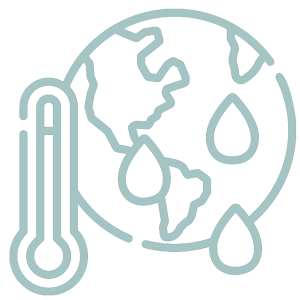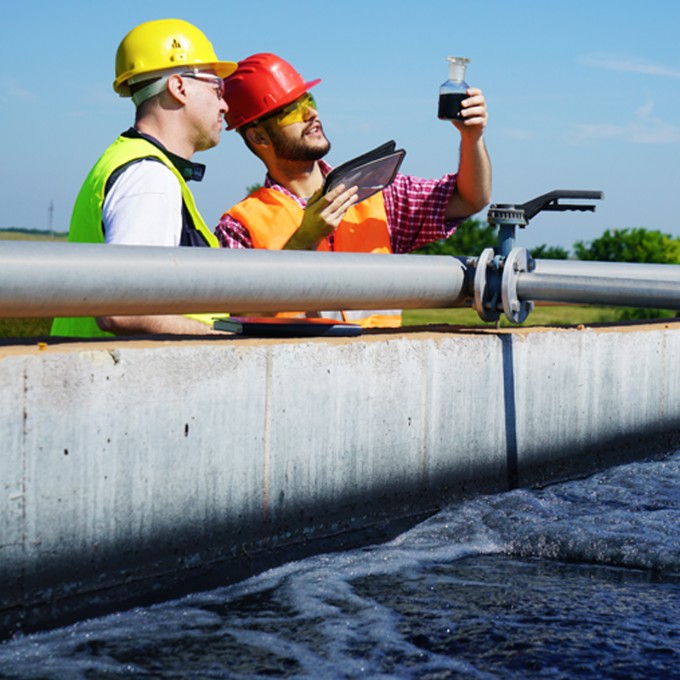Taking the future of water into your hands
December 2022

Water is occupying an increasingly prominent place on the economic and political agenda. As a result of the changing climate, we will have to contend with extreme weather conditions more often. These can lead to both flooding and water shortages. Companies that are looking for solutions to the water issues deserve our attention more than ever.
Alex Martens, fund manager & sector analist Industrials

What exactly are these 'water companies'?

Infrastructure
- Designing, building and maintaining dams, pipelines, water towers, etc.
- Building machines and equipment such as pumps, smart meters, etc.

Water treatment and efficiency improvement
- Private and industrial water filtration and treatment
- Quality control
- Leak detection, desalination, water-saving toilets and shower controls, etc.

Utilities
- Production
- Distribution

70% of the Earth’s surface consists of water, but only 1% can be used as drinking water. That water is moreover very unevenly distributed. Four countries – Brazil, Russia, Canada and the US – contain 10% of the world’s population but almost 40% of its water reserves. By contrast, China and India have more than 30% of the global population but only 10% of the water reserves.
70% of global water consumption is used in agriculture and stock farming; industry uses 20%, while 10% ends up in our domestic taps. On average, each of us consumes more than 100 litres of water per day.
There are more of us. That also means more of us to consume water. The global population is projected to grow by around two billion by 2050, to almost 10 billion.
On top of that, water consumption is rising twice as fast as population growth, because our living standards are also rising. That is a particularly significant factor in emerging countries such as India and China. More households are gaining access to basic comforts such as a shower, toilet, washing machine, etc. And they are also consuming more: think of smartphones, cars, etc.: their production processes also consume thousands of litres of water.

Environment and climate
Deforestation and urbanisation destroy the ecosystems that are crucial for groundwater replenishment. In combination with global warming and excessive usage, this is steadily exhausting the global water reserves.
At the same time deforestation, urbanisation and paving also increase the risk of flooding. Investing in space for water and in softening is therefore an investment in less water problems.

Pollution
Pollution damages natural water sources : 80% of Chinese rivers are so polluted that they can no longer sustain life. Worldwide, only 20% of waste-water is treated and recycled.

Old, leaky infrastructure
Maintaining water infrastructure costs a lot of money and was readily deferred in the past. In the US, 23 billion litres of drinking water are lost through leakage every day. In Flanders, the figure is 180 million litres.
To bridge the gap between supply and demand, we not only need to use water more sustainably. It is also crucial to invest. As a result of climate change, we will have to contend with more extreme weather conditions. To bridge periods of drought, but also to counteract flooding during periods of heavy rainfall, investments are needed in extra space to store water, such as in buffer and waiting basins, infiltration wells and cisterns.
According to research by McKinsey, no less than 11 700 billion USD is needed for investments in infrastructure in order to meet the demand for water by 2030. American President Biden's infrastructure plan seems to be a step in the right direction.

- The shortage of drinking water, the need to maintain and expand infrastructure, and higher standards for water quality, create stable turnover growth for water companies. This turnover growth in turn translates into solid earnings growth and explains their strong performance on the stock markets over the last ten years.
- The problems in the supply chains in the semiconductor sector offer an additional opportunity. The demand for chips in just about everything, from cars to computer games or electric toothbrushes, has increased worldwide. Capacity must be increased. The production of semiconductors involves the use of pure water. Companies that are active in the process of clean water stand to benefit from this.
- Investing in water is partly cyclical and partly non-cyclical.
- Water infrastructure, for example, is highly cyclical. When the economy is doing well, more houses are built, public investment increases and companies make bigger investments in maintenance and expansion. The expected economic growth, combined with extra government investments, should provide a stimulus for these companies.
- Companies active in areas such as testing water quality or water treatment are less dependent on the economic cycle. They often operate in niche markets, and boast strong balance sheets and high liquidity
Demand for water will always be there, whatever happens, creating an endless growth narrative for water companies.

There is one caveat to the growth narrative of water: the price/earnings ratio is traditionally higher than for the broad market. This premium can be justified when higher economic growth is to be expected. However, since the coronavirus crisis, this premium no longer applies. The economic recovery and government investments in new infrastructure works are in any case positive for water companies.

Did you know that...?
… there is music in leak detection technology
‘Acoustic monitoring‘ helps detect expensive leaks in pipelines and thus water losses. Special equipment is used at night to listen for ‘leakage sounds’ or vibrations. These acoustic monitors are generally used in conjunction with smart meters. The data is collected, forwarded and analysed. This makes it easy to establish the physical location of a leak, enabling repairs to be carried out faster and more efficiently.
Redaction finalized 31st of December 2022
This document is a publication of KBC Asset Management NV (KBC AM). The information in it can be changed without notice and offers no guarantee for the future. Nothing in this document may be reproduced without the prior, express, written consent of KBC AM. This information is governed by the laws of Belgium and is subject to the exclusive jurisdiction of its courts.
